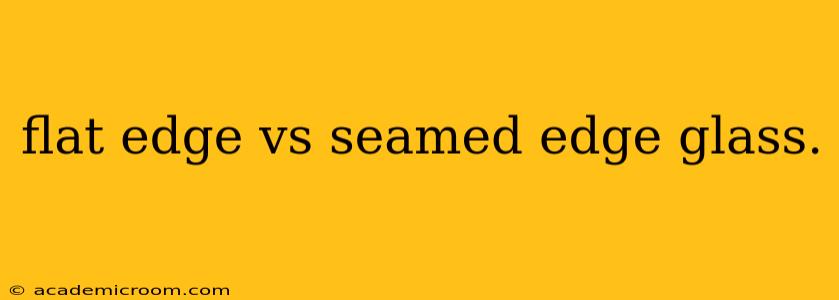Choosing the right type of glass for your project can feel overwhelming, especially when faced with options like flat edge and seamed edge glass. Both offer unique aesthetic qualities and practical considerations, making the selection crucial for the final look and longevity of your project. This comprehensive guide will break down the differences, helping you make an informed decision.
What is Flat Edge Glass?
Flat edge glass, also known as "polished edge" glass, features a cleanly polished edge, resulting in a smooth, refined finish. This processing removes any irregularities left from the manufacturing process, creating a sleek, modern appearance. The edges are precisely ground and polished, making them safe to handle and ideal for various applications. The absence of any seam makes it a popular choice for minimalist designs and applications where a clean, uncluttered look is desired.
Advantages of Flat Edge Glass:
- Sleek and Modern Appearance: The polished edge creates a sophisticated, contemporary aesthetic.
- Safety: The smooth, polished edges minimize the risk of cuts or injuries.
- Versatility: Suitable for a wide range of applications, including shower enclosures, tabletops, and shelves.
- Easy to Clean: The smooth surface is easy to maintain and clean.
Disadvantages of Flat Edge Glass:
- Higher Cost: The extra processing required to achieve the polished edge typically increases the cost compared to seamed edge glass.
- More Susceptible to Chipping: While safer to handle, the flat edge can be more susceptible to chipping if impacted.
What is Seamed Edge Glass?
Seamed edge glass, sometimes called "rough edge" glass, retains the slightly uneven, rough edge created during the manufacturing process. It's generally less expensive than flat edge glass due to the lack of additional polishing. This type of glass lends itself to a more rustic or industrial aesthetic.
Advantages of Seamed Edge Glass:
- Lower Cost: The absence of polishing makes it a more budget-friendly option.
- Rustic Charm: The raw, unpolished edges offer a unique, natural look, perfect for rustic or industrial designs.
- Durability (in some applications): In certain applications, the slightly irregular edges may offer increased durability to impact.
Disadvantages of Seamed Edge Glass:
- Rough Edges: The unpolished edges can be sharp and potentially hazardous, requiring careful handling and potentially additional safety measures.
- Less Versatile: It might not be suitable for all applications, particularly those requiring a polished, refined look.
- More Difficult to Clean: The uneven surface can make cleaning more challenging.
What are the different applications for each type of glass?
Flat Edge Glass: Ideal for applications where a sleek, modern aesthetic is desired, including:
- Shower Enclosures: Provides a clean, contemporary look and improved safety.
- Tabletops: Creates a smooth, elegant surface perfect for dining or display.
- Shelving: Offers a refined, minimalist appearance in any room.
- Mirrors: Provides a frameless, modern look.
Seamed Edge Glass: Best suited for projects emphasizing a rustic or industrial style, such as:
- Decorative accents: Adds a unique, raw element to interior design.
- Industrial-style furniture: Enhances the character of furniture pieces.
- Exterior applications (with consideration for safety): Certain exterior applications may benefit from its ruggedness, but safety must be prioritized.
Which type of glass is safer?
While both can be safe when handled and installed properly, flat edge glass is generally considered safer due to its smooth, polished edges. The lack of sharp points significantly reduces the risk of cuts or injuries. Seamed edge glass, however, poses a higher risk of injury from its sharp, irregular edges unless additional safety measures (like edging) are taken.
How much does each type of glass cost?
The cost difference varies based on size, thickness, and supplier, but generally, seared edge glass is less expensive than flat edge glass. The additional processing required for polishing increases the cost of flat edge glass.
Which type of glass is best for my project?
The best choice depends entirely on your project’s aesthetic goals, budget, and intended use. If a sleek, modern look and safety are paramount, flat edge glass is the superior choice. If a rustic charm and lower cost are priorities, seamed edge glass might be more suitable. Always consult with a glass professional to ensure the chosen glass is appropriate for your specific application.
